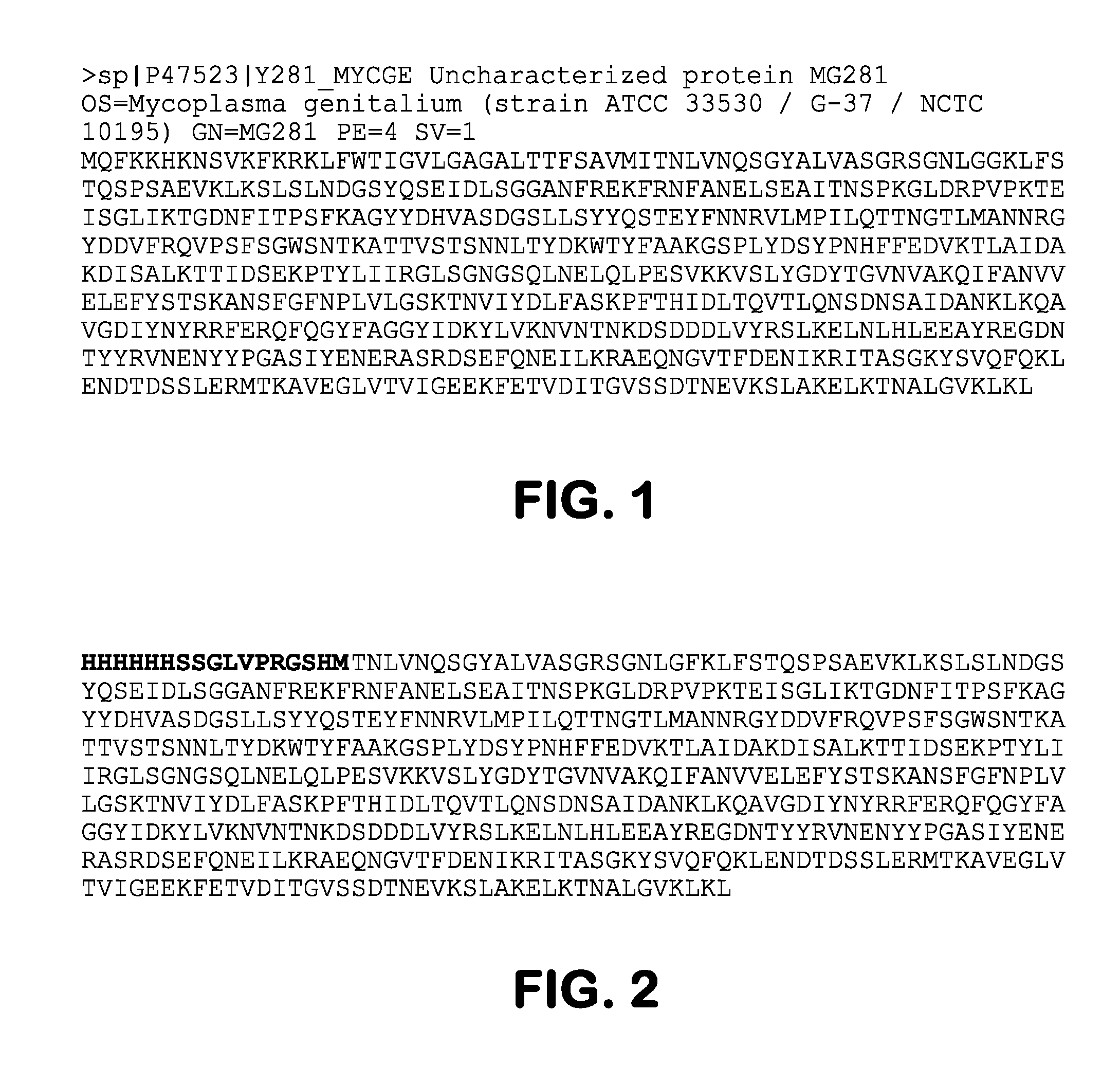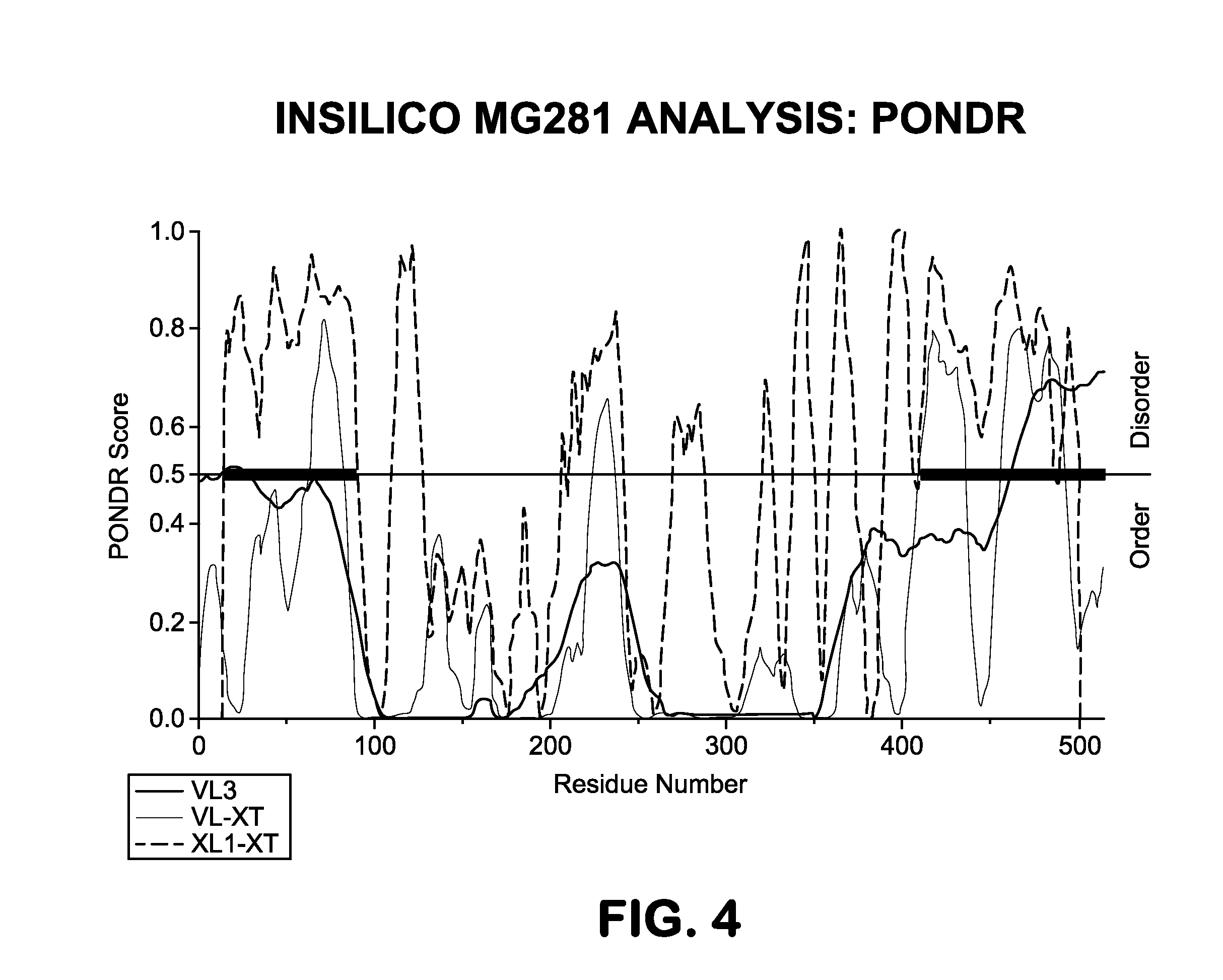Immunoglobuljin-binding human mycoplasma antigens and methods of use thereof
- Summary
- Abstract
- Description
- Claims
- Application Information
AI Technical Summary
Benefits of technology
Problems solved by technology
Method used
Image
Examples
example 1
Myeloma Plasma Immunoglobulins Bind to Mycoplasma Antigen MG281
[0088]The present study demonstrated that a majority of monoclonal immunoglobulins (Ig) from the sera of 80 patients with monoclonal gammopathy of undetermined significance (MGUS) or frank multiple myeloma (MM), showed highly selective reactivity with an antigen from human Mycoplasma genitalium and Mycoplasma penetrans, but not from a set of other human or animal mycoplasmas. It was further shown that that human plasma cell lines from a subset of MM patients secreting intact Ig 10 / 14 exhibited similar reactivity to this mycoplasma antigen. To show that reactivity was associated with the monoclonal paraprotein, the immunoglobulin Fab fragment from one MM patient was crystallized and the structure was determined to a 1.2 Å resolution. The dissolved crystals of the Fab fragments of the immunoglobulin molecules retained reactivity to the mycoplasma antigen, thereby confirming the direct connection to the monoclonal paraprote...
example 2
MG281 is Mitogenic
[0104]The binding specificity showed that MG281 (Protein M) has the properties of a class or non-specific immunoglobulin binding proteins, sometimes referred to as B-cell super antigens. B-cell superantigens can cause either apoptosis or proliferation of lymphocytes. To determine whether Protein-M was functional, we tested its ability to stimulate B-cells. We tested full-length rProtein-M (rProtein-M FL), a purified 40 kD fragment obtained after trypsin digestion of rProtein-M (rProtein-M TD) and endotoxin free full length rProtein-M (EF rProtein-M FL) in a luminescence based BrDU proliferation ELISA assay. The mitogenicpotential of Protein-M and it's derivatives was compared to a cross-linked mouse anti-human IgG / anti-mouse IgG pair (IgG-IgG) and E. coli LPS. Addition of rProtein-M to CD19+ human B-cells induced cellular proliferation, suggesting that Protein-M is able to engage the B-cell receptor (BCR) and initiate a downstream cascade leading to cell proliferat...
example 3
MG281 Inhibits Antibody-Antigen Union
[0109]The structural studies suggested that protein-M should preclude the ability of the antibody to bind to its antigen because it distorts the CDRs and may use its c-terminal domain to cover the entrance to the antibody-combining site. We tested the ability of protein-M to block antigen-antibody union for six different antigen-antibody pairs, two of which were polyclonal. As detailed below, prior incubation of the antibody with protein-M completely inhibited binding to its cognate antigen. The order of addition is critical. However, once antigen-antibody union has occurred, protein-M is unable to disrupt the complex in most cases. This may occur because of steric effects or a change in the conformation of the CDR's in the presence of antigen. Whereas in case of small hepatitis C glycoprotein antigen-antibody complex, a full tertiary complex was observed. Furthermore, to test the importance of the canonical relationship of the CDR's to protein-M...
PUM
 Login to View More
Login to View More Abstract
Description
Claims
Application Information
 Login to View More
Login to View More - R&D
- Intellectual Property
- Life Sciences
- Materials
- Tech Scout
- Unparalleled Data Quality
- Higher Quality Content
- 60% Fewer Hallucinations
Browse by: Latest US Patents, China's latest patents, Technical Efficacy Thesaurus, Application Domain, Technology Topic, Popular Technical Reports.
© 2025 PatSnap. All rights reserved.Legal|Privacy policy|Modern Slavery Act Transparency Statement|Sitemap|About US| Contact US: help@patsnap.com



